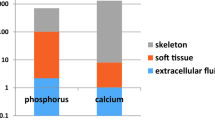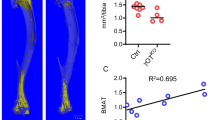Abstract
Iron overload increases the risk of osteoporosis, which leads to an increase in the incidences of bone fracture after menopause. In vitro studies have demonstrated that excess iron can inhibit osteoblast activity. Hepcidin, a central regulator of iron homeostasis, prevents iron overload, and thus, it is considered to have anti-osteoporosis effects. In this study, a zebrafish model was employed to investigate the therapeutic role of hepcidin in iron overload-induced inhibition of bone formation. Our results show that ferric ammonium citrate (FAC) treatment decreased osteoblast-specific gene expression (runx2a, runx2b, and bglap) and bone mineralization in the zebrafish embryo, accompanied with increased whole-body iron levels and oxidative stress. Bone mineralization and osteoblast-specific gene expression increased with the microinjection of hepcidin-flag Capped-mRNA into zebrafish embryos. Moreover, the whole-body iron content and oxidative stress in the iron-overloaded zebrafish embryos decreased when microinjection of hepcidin preceded the FAC treatment. Therefore, our study suggests that hepcidin could prevent and rescue reduced bone formation caused by FAC treatment by preventing iron absorption.





Similar content being viewed by others
Abbreviations
- ICP-MS:
-
inductively coupled plasma mass spectrometry
- DCFH-DA:
-
2′,7′-dichlorofluorescein-diacetate
- FAC:
-
ferric ammonium citrate
References
Ahsan H, Ali A, Ali R (2003) Oxygen free radicals and systemic autoimmunity. Clin Exp Immunol 131(3):398–404
Fleming A, Sato M, Goldsmith P (2005) High-throughput in vivo screening for bone anabolic compounds with zebrafish. J Biomol Screen 10(8):823–831
Ganz T, Olbina G, Girelli D, Nemeth E, Westerman M (2008) Immunoassay for human serum hepcidin. Blood 112(10):4292–4297
Guggenbuhl P, Deugnier Y, Boisdet JF, Rolland Y, Perdriger A, Pawlotsky Y, Chales G (2005) Bone mineral density in men with genetic hemochromatosis and HFE gene mutation. Osteoporos Int 16(12):1809–1814
Guggenbuhl P, Fergelot P, Doyard M, Libouban H, Roth MP, Gallois Y, Chales G, Loreal O, Chappard D (2011) Bone status in a mouse model of genetic hemochromatosis. Osteoporos Int 22(8):2313–2319
Guo S, Casu C, Gardenghi S, Booten S, Aghajan M, Peralta R, Watt A, Freier S, Monia BP, Rivella S (2013) Reducing TMPRSS6 ameliorates hemochromatosis and beta-thalassemia in mice. J Clin Invest 123(4):1531–1541
Hentze MW, Muckenthaler MU, Andrews NC (2004) Balancing acts: molecular control of mammalian iron metabolism. Cell 117(3):285–297
Huang X (2010) Treatment of osteoporosis in peri- and post-menopausal women with hepcidin. United States Patent Application Publication, Pub No:US 2010/0204122 A1
Javed M, Saeed MA (2010) Growth and bioaccumulation of iron in the body organs of Catla catla, Labeo rohita and Cirrhina mrigala during chronic exposures. Int J Agric Biol 12:881–886
Jia P, Xu YJ, Zhang ZL, Li K, Li B, Zhang W, Yang H (2012) Ferric ion could facilitate osteoclast differentiation and bone resorption through the production of reactive oxygen species. J Orthop Res 30(11):1843–1852
Kim BJ, Ahn SH, Bae SJ, Kim EH, Lee SH, Kim HK, Choe JW, Koh JM, Kim GS (2012) Iron overload accelerates bone loss in healthy postmenopausal women and middle-aged men: a 3-year retrospective longitudinal study. J Bone Miner Res 27(11):2279–2290
Kim BJ, Lee SH, Koh JM, Kim GS (2013) The association between higher serum ferritin level and lower bone mineral density is prominent in women >/=45 years of age (KNHANES 2008-2010). Osteoporos Int 25(2):789–790
Li ZX, Chen JW, Yuan F, Huang YY, Zhao LY, Li J, Su HX, Liu J, Pang JY, Lin YC, Lu XL, Pei Z, Wang GL, Guan YY (2013) Xyloketal B exhibits its antioxidant activity through induction of HO-1 in vascular endothelial cells and zebrafish. Mar Drugs 11(2):504–522
Ma Y, Xu YJ, Wang AD, Yu C, Wang B, Zhang P, Zhang ZD (2006) A preliminary report of expression of hepcidin gene in SD rats osteoporosis model. Suzhou Univ J Med Sci 26:367–369
MacKenzie EL, Iwasaki K, Tsuji Y (2008) Intracellular iron transport and storage: from molecular mechanisms to health implications. Antioxid Redox Signal 10(6):997–1030
Messer JG, Kilbarger AK, Erikson KM, Kipp DE (2009) Iron overload alters iron-regulatory genes and proteins, down-regulates osteoblastic phenotype, and is associated with apoptosis in fetal rat calvaria cultures. Bone 45(5):972–979
Nemeth E, Tuttle MS, Powelson J, Vaughn MB, Donovan A, Ward DM, Ganz T, Kaplan J (2004) Hepcidin regulates cellular iron efflux by binding to ferroportin and inducing its internalization. Science 306(5704):2090–2093
Nicolas G, Viatte L, Lou DQ, Bennoun M, Beaumont C, Kahn A, Andrews NC, Vaulont S (2003) Constitutive hepcidin expression prevents iron overload in a mouse model of hemochromatosis. Nat Genet 34(1):97–101
Ramos E, Ruchala P, Goodnough JB, Kautz L, Preza GC, Nemeth E, Ganz T (2012) Minihepcidins prevent iron overload in a hepcidin-deficient mouse model of severe hemochromatosis. Blood 120(18):3829–3836
Sarrai M, Duroseau H, D'Augustine J, Moktan S, Bellevue R (2007) Bone mass density in adults with sickle cell disease. Br J Haematol 136(4):666–672
Tsay J, Yang Z, Ross FP, Cunningham-Rundles S, Lin H, Coleman R, Mayer-Kuckuk P, Doty SB, Grady RW, Giardina PJ, Boskey AL, Vogiatzi MG (2010) Bone loss caused by iron overload in a murine model: importance of oxidative stress. Blood 116(14):2582–2589
Valenti L, Varenna M, Fracanzani AL, Rossi V, Fargion S, Sinigaglia L (2009) Association between iron overload and osteoporosis in patients with hereditary hemochromatosis. Osteoporos Int 20(4):549–555
Voskaridou E, Terpos E (2004) New insights into the pathophysiology and management of osteoporosis in patients with beta thalassaemia. Br J Haematol 127(2):127–139
Weber DN (2006) Dose-dependent effects of developmental mercury exposure on C-start escape responses of larval zebrafish Danio rerio. J Fish Biol 69:75–94
Youjia Xu, Pierre Sirois, Kai Li (2010) Iron overload plays a unique role in osteoporosis. [E-letter]Blood http://bloodjournal.hematologylibrary.org/content/116/14/2582.full/reply#bloodjournal_el_524
Zhang S, Xu M, Huang J, Tang L, Zhang Y, Wu J, Lin S, Wang H (2014) Heme acts through the Bach1b/Nrf2a-MafK pathway to regulate exocrine peptidase precursor genes in porphyric zebrafish. Dis Model Mech 7(7):837–845
Funding
This work was supported in part by grants from the National Natural Science Foundation of China (81602864), National Advance Natural Science Foundation of China (SDFEGJ1601), Jiangsu Province Special Medical Grant (BL2014044), Suzhou Clinical Key Special Diseases Fund (LCZX210305), and Jiangsu Youth Medical Foundation of China (QNRC2016149).
Author information
Authors and Affiliations
Corresponding author
Ethics declarations
Animal care and all the experiments were performed in accordance with the institutional ethical guidelines for animal experiments, and all experimental procedures using fish were approved by the Soochow University Committee on Animal Use and Care.
Conflict of interest
The authors declare that they have no conflict of interest.
Electronic supplementary material
ESM 1
(DOCX 16 kb)
Rights and permissions
About this article
Cite this article
Jiang, Y., Chen, B., Yan, Y. et al. Hepcidin protects against iron overload-induced inhibition of bone formation in zebrafish. Fish Physiol Biochem 45, 365–374 (2019). https://doi.org/10.1007/s10695-018-0568-z
Received:
Accepted:
Published:
Issue Date:
DOI: https://doi.org/10.1007/s10695-018-0568-z




